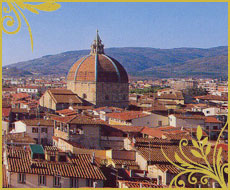

Historical Notes
he present Via Buonfanti was likely to lie on the same guiding line of the old Cassia, the main Roman road of communication connecting Lucca to Florence and crossing Pistoia, in Piazza del Duomo (just on the site of the recent Via degli Orafi) on the exact location of the first inhabited core (II c. b.c.) firstly as Roman “castrum” (military camp) and then as “oppidum” (fortified military camp).
Between XII and XIII c. just during the most glorious cultural, artistic and economic period for Pistoia, the street as well as the corresponding extra-urban San Bartolomeo Quarter (the most populated at that time) were subjected by that process of the urban tissue’s enlargement, that involved all the town peaking with the second wall circle’s edification.
In 1387 the road which was likely to be spread with tower houses, with their back kitchen gardens (the typical civil medieval buildings) is quoted as “Lungamastra” of San Marco Quarter or rather the “Ruga Mastra”, the high road leading from the town centre to one of the wall gates, that is P.ta San Marco representing the axis of the new urban expansion.
In the late Middle Ages the neighbourhood of San Marco, the easter suburb, was supplied with a great amount of streams and mill-races, becoming the more fruitful area in the town, with the Abbey of San Bartolomeo noted as an important centre of agricultural conversion, through its two mills and its oil-press. That quarter was enriched by fair patrician palaces, decorated with rustication and stone coats of arms, such as Palazzo Cancellieri, Palazzo Rospigliosi and Palazzo Buonfanti.
It’s certain the present street “Buonfanti”, quoted for the first time in 1777, was named after the Buonfantis, mentioned among the Pistoia families before XV c.. That family, recorded for some prestigious characters of Gonfalonier, settled in the dwelling from 1705, today seat of the omonimous Relais. Owned by Mr Antonio Bonfanti in 1777, the structure, comprehensive of a back kitchen garden as well as a fountain basin, in 1836 was transferred to Knt. Pietro Bouffant, once Antonio.
In XIX c. the palace belonged to a certain Mr Bonacchi Arturo, then in 1923 it was purchased by Mariani Carlo, as soon as he came back from America. There he had migrated alike many of his fellow citizens in search for success and achieved his object working in the cotton plantations in New Messico. In the ancient residence Buonfanti he established with his wife, setting up on the ground floor a inn-taproom, which soon after, known as “Trattoria dell’Americano” “The American’s restaurant” would be become a meeting point of the old neighbourhood, as well as of the town itself. It was a place where to taste some glass of wine, refresh oneself with local courses such as: “biroldi”, “migliacci”, “rigaglia”, “carcerato”, etc. and enjoying playing cards or bowling in the back kitchen garden. In 1952 the inn was handed over his son Mariani Ferruccio who then sold the activity.
Today in 2008 Lara Selmi, his grand-daughter, with all her family tries to keep alive this sense of cordiality, hospitality and reception inherited by her own grand grandfather, in the way of proposing her Relais to anyone aims at “living” thoroughly Pistoia and Tuscany, too, that is to say discovering as well as enjoying the thousand resources this region may offer, from the artistic, naturalistic and folkloric beauties to the typical and delicious dishes of the local tradition basted by the prestigious wines of the Chianti and Montalbano hills.
